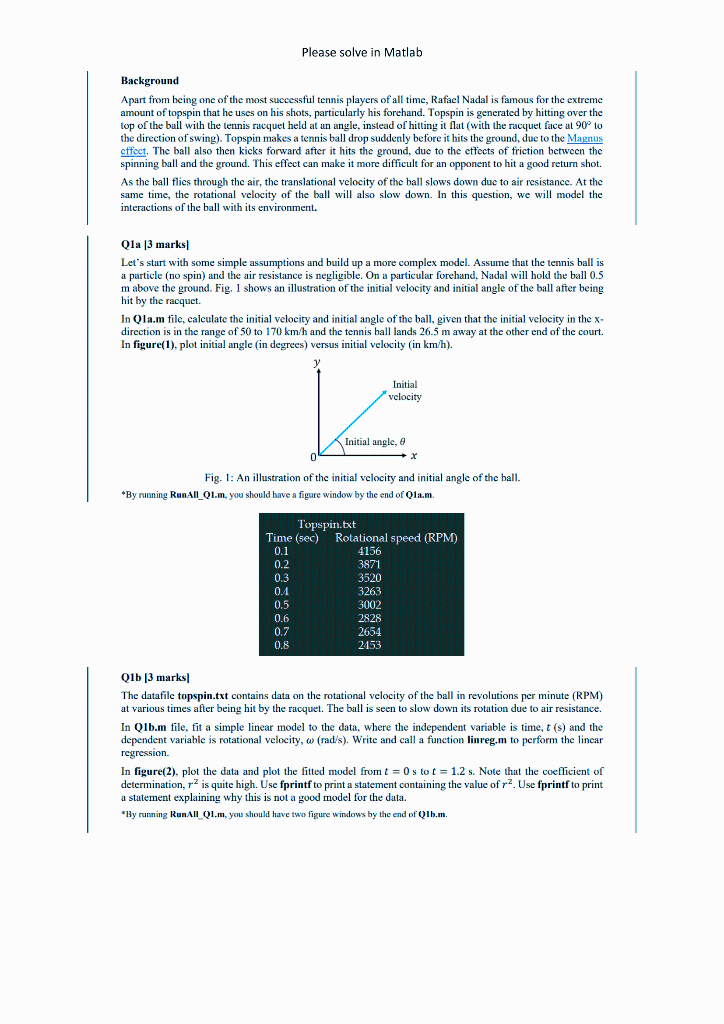Answered step by step
Verified Expert Solution
Question
1 Approved Answer
Background Apart from being one of the most successful tennis players of all time, Rafael Nadal is famous for the extreme amount of topspin that


Background Apart from being one of the most successful tennis players of all time, Rafael Nadal is famous for the extreme amount of topspin that he uses on his shots, particularly his forehand. Topspin is generated by hitting over the top of the ball with the tennis racquet held at an angle, instead of hitting it flat (with the racquet face at 90 to the direction of swing). Topspin makes a tennis ball drop suddenly before it hits the ground, due to the Magnus cffect. The ball also then kicks forward after it hits the ground, due to the effects of friction between the spinning ball and the ground. This effect can make it more difficult for an opponent to hit a good return shot. As the ball flies through the air, the translational velocity of the ball slows down due to air resistance. At the same time, the rotational velocity of the ball will also slow down. In this question, we will model the interactions of the ball with its environment. Q1a [3 marks] Let's start with some simple assumptions and build up a more complex model. Assume that the tennis ball is a particle (no spin) and the air resistance is negligible. On a particular forehand, Nadal will hold the ball 0.5 m above the ground. Fig. 1 shows an illustration of the initial velocity and initial angle of the ball after being hit by the racquet. In Q1a.m file, calculate the initial velocity and initial angle of the ball, given that the initial velocity in the x direction is in the range of 50 to 170km/h and the tennis ball lands 26.5m away at the other end of the court. In figure(1), plot initial angle (in degrees) versus initial velocity (in km/h ). Fig. 1: An illustration of the initial velocity and initial angle of the ball. "By running RanAll_Q1.m. you should have a figure window by the end of Q1a.m. Q1b [3 marks] The datafile topspin.txt contains data on the rotational velocity of the ball in revolutions per minute (RPM) at various times after being hit by the racquet. The ball is seen to slow down its rotation due to air resistance. In Q1b.m file, fit a simple linear model to the data, where the independent variable is time, t (s) and the dependent variable is rotational velocity, (rad/s). Write and call a function linreg.m to perform the linear regression. In figure(2), plot the data and plot the fitted model from t=0s to t=1.2s. Note that the coefficient of determination, r2 is quite high. Use fprintf to print a statement containing the value of r2. Use fprintf to print a statement explaining why this is not a good model for the data. "By running RunAll_Q1.m, you should have two figure windows by the end of Qlb.m. Q1c [3 marks] If we assume the air resistance varies with rotational velocity in such a way airresistance1 then an exponential decay model =AeBt would be an appropriate curve fitting model for a relationship between and t. In Q1e.m file, fit the exponential decay model to the data and plot the fitted model according in the same figure(2). Based on this model, predict what is the initial rotational velocity when the ball lefts the racquet. Use fprintf to print a statement containing the initial rotational velocity. "By ruaning RunAll_Q1.m, you should bave two figure windows by the end of Q1c.m
Step by Step Solution
There are 3 Steps involved in it
Step: 1

Get Instant Access to Expert-Tailored Solutions
See step-by-step solutions with expert insights and AI powered tools for academic success
Step: 2

Step: 3

Ace Your Homework with AI
Get the answers you need in no time with our AI-driven, step-by-step assistance
Get Started


